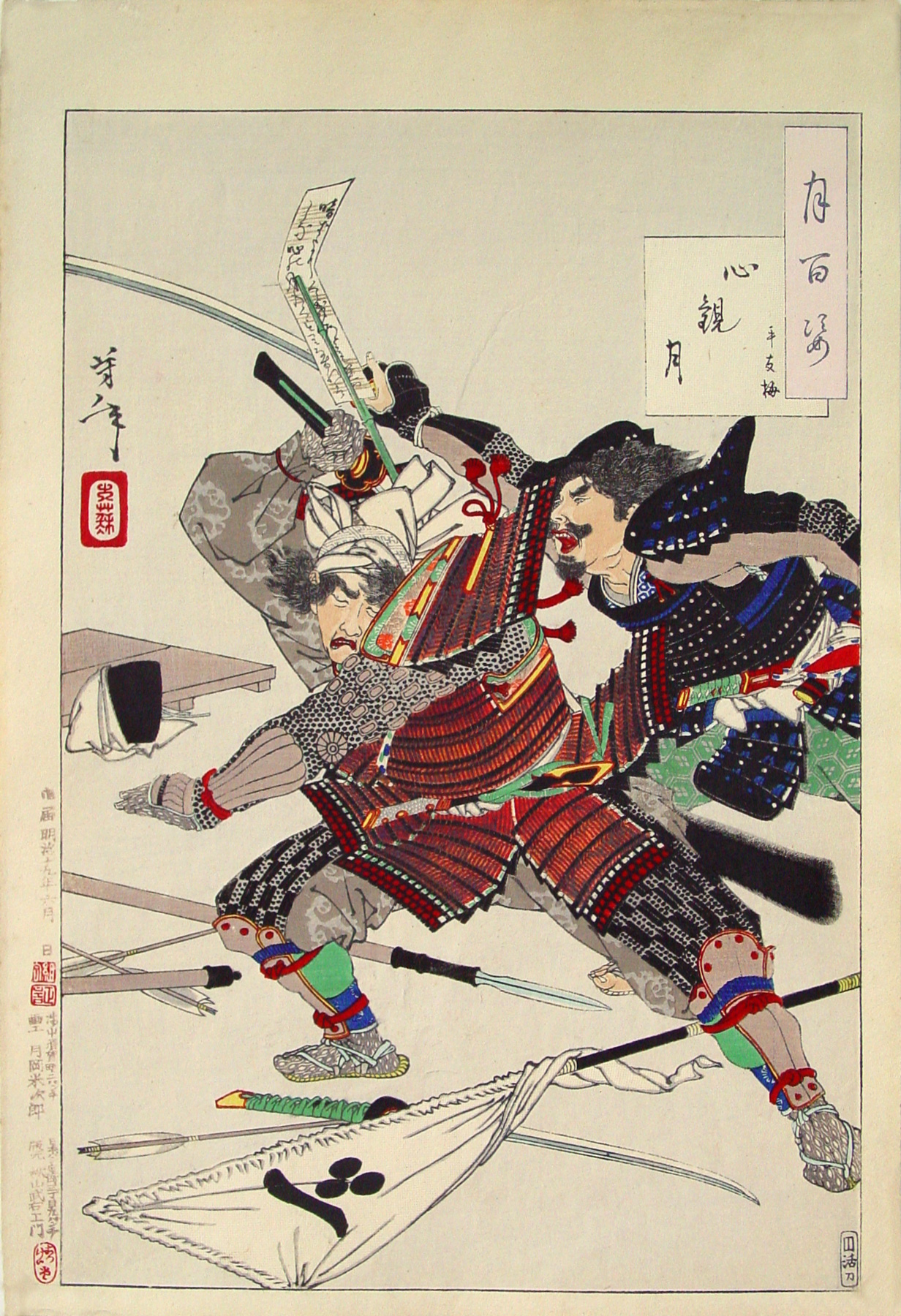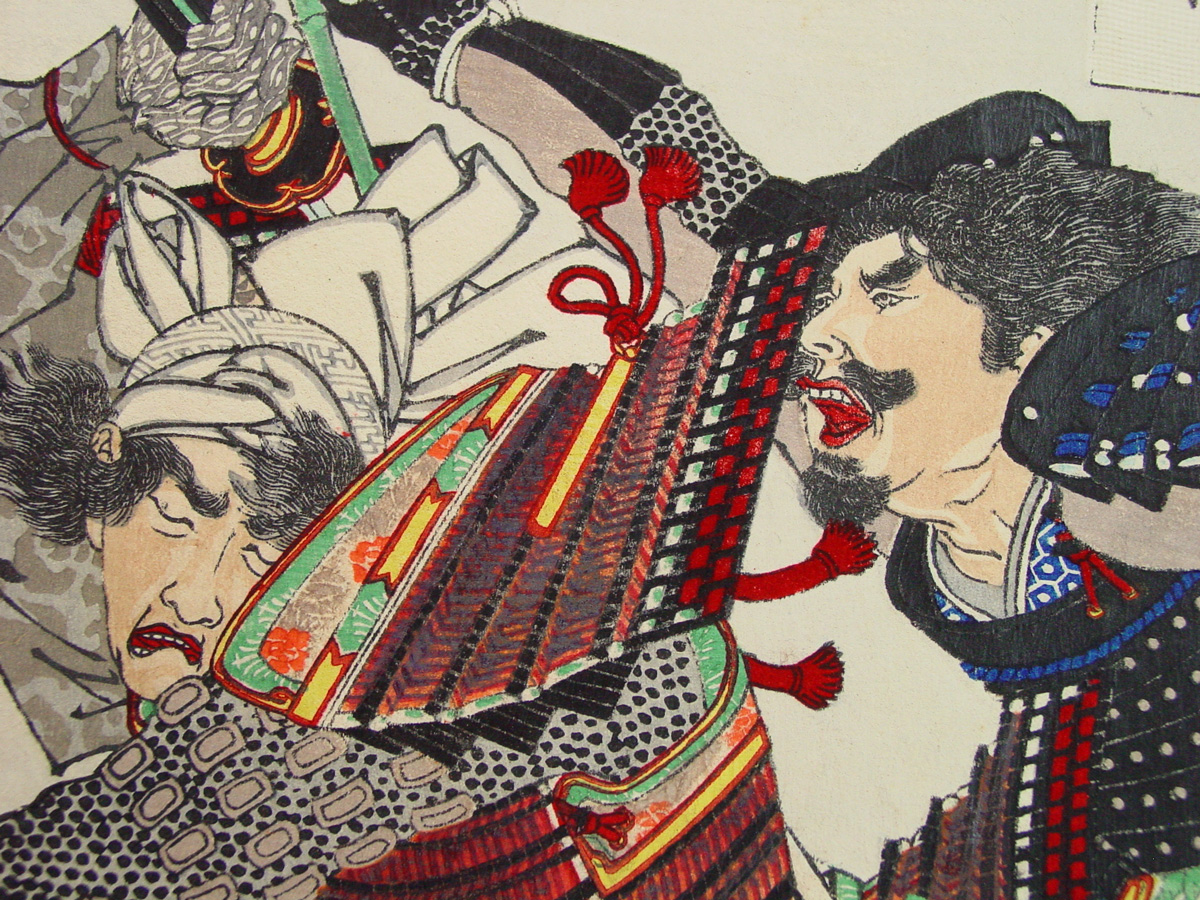About This Print
Source: Museum of International Folk Art http://www.internationalfolkart.org/exhibitions/past/moonweb/section2/041.htm
Taira no Tomoume, a blind warrior, uses second sight to see his enemies and survive in battle. He carries a poem slip as a talisman. The verse reads, From darkness I have wandered lost on to a darker path; the moon of heart is becoming clouded.An early, if not first, state of this print.
34.
The Story Depicted in the Print as Told by John Stevenson
Source: Yoshitoshi's One Hundred Aspects of the Moon, John Stevenson, Hotei Publishing, Netherlands 2001.34.
The moon’s inner vision – Taira no Tomoume
shinkan no tsuki – Taira no Tomoume
Taira no Tomoume was a blind warrior who joined his family’s struggle against the Minamoto clan in the second half of the twelfth century. This print illustrates his death battle as he parries a blow directed at him from behind. The scattered weapons and fallen standard indicate the ferocity of the fight. A courtier’s lacquered hat, wrapped in cloth, has fallen to the ground; its significance is unclear.
The moon is an important element of the design even though it cannot be seen. Tomoume has fastened a cleft stick containing a tanka poem on his back as his personal emblem; the poem reads,
This poem was a talisman that Tomoume used to protect and guide him, and was presumably one that he had written himself or on which he had meditated for a long time. It expresses the isolation that he must have felt as a blind man. It was not uncommon for a warrior to wear an emblem that had personal meaning to him in this way – elsewhere in the Moon Series, a general carries a skull on his back.
Tomoume’s isolation is also suggested by the background, which is flat and simplified as if seen in moonlight. If Tomoume was a sort of twelfth-century Zatoichi, a blind swordsman who developed an almost tactile awareness of his surroundings, this might be how he would have “seen” the scene. The moon is not illustrated in the print – we see the moon by reading the poem, in the same way that Tomoume was obliged to visualize the moon. By the device of the poem, we are drawn behind his blind eyes.
The kokoro of the poem and the shin in the title of the print are the Japanese and Chinese pronunciations of the same character, which means “heart,” or “mind.” Another translation of the title might be “seeing the moon with the heart.”
Tomoume’s poem is based on a poem by the eleventh-century poetess, Izumi Shikibu, famous for love poems that are often passionate but which also voice anxiety, pain, and their resolution:
The moon in both poems may be an allusion to Buddhist enlightenment.
Though many of the designs of the One Hundred Aspects of the Moon illustrate warriors, all but two are shown in quiet moments. This design contains the most furious action of the series, and even here Yoshitoshi refrains from showing the blood that characterizes his earlier warrior prints. By this time in his life he had become more interested in the human emotions associated with battle than with the violence itself. Perhaps he saw special poignancy in the act of a blind man fighting to the death.
shinkan no tsuki – Taira no Tomoume
Taira no Tomoume was a blind warrior who joined his family’s struggle against the Minamoto clan in the second half of the twelfth century. This print illustrates his death battle as he parries a blow directed at him from behind. The scattered weapons and fallen standard indicate the ferocity of the fight. A courtier’s lacquered hat, wrapped in cloth, has fallen to the ground; its significance is unclear.
The moon is an important element of the design even though it cannot be seen. Tomoume has fastened a cleft stick containing a tanka poem on his back as his personal emblem; the poem reads,
| kuraki yori kuraki michi ni zo mayoishi na kokoro no tsuki no kumori narunari | from darkness I have wandered lost on to a darker path the moon of my heart is becoming clouded |
This poem was a talisman that Tomoume used to protect and guide him, and was presumably one that he had written himself or on which he had meditated for a long time. It expresses the isolation that he must have felt as a blind man. It was not uncommon for a warrior to wear an emblem that had personal meaning to him in this way – elsewhere in the Moon Series, a general carries a skull on his back.
Tomoume’s isolation is also suggested by the background, which is flat and simplified as if seen in moonlight. If Tomoume was a sort of twelfth-century Zatoichi, a blind swordsman who developed an almost tactile awareness of his surroundings, this might be how he would have “seen” the scene. The moon is not illustrated in the print – we see the moon by reading the poem, in the same way that Tomoume was obliged to visualize the moon. By the device of the poem, we are drawn behind his blind eyes.
The kokoro of the poem and the shin in the title of the print are the Japanese and Chinese pronunciations of the same character, which means “heart,” or “mind.” Another translation of the title might be “seeing the moon with the heart.”
Tomoume’s poem is based on a poem by the eleventh-century poetess, Izumi Shikibu, famous for love poems that are often passionate but which also voice anxiety, pain, and their resolution:
| kuraki yori kuraki michi ni zo irinubeki harukani terase yama no ha no tsuki | from darkness I have entered a darker path shine out moon at the edge of the mountain |
Though many of the designs of the One Hundred Aspects of the Moon illustrate warriors, all but two are shown in quiet moments. This design contains the most furious action of the series, and even here Yoshitoshi refrains from showing the blood that characterizes his earlier warrior prints. By this time in his life he had become more interested in the human emotions associated with battle than with the violence itself. Perhaps he saw special poignancy in the act of a blind man fighting to the death.
Image from Publisher's Bound Album (Issued shortly after Yoshitoshi's death)
About the Series "One Hundred Aspects of the Moon"For details about this series which consists of one hundred prints with the moon as a unifying motif, see the article on this site Yoshitoshi, One Hundred Aspects of the Moon.
Print Details
| IHL Catalog | #87 |
| Title | The Moon’s Inner Vision – Taira no Tomoume (shinkan no tsuki - Taira no Tomoume 心観月 平友梅) |
| Series | One Hundred Aspects of the Moon (Tsuki hyaku sugata 月百姿) |
| John Stevens Reference No.* | 34 |
| Artist | Tsukioka Yoshitoshi (1839-1892) |
| Signature | Yoshitoshi 芳年 |
| Seal | Taiso 大蘇 |
| Date | June 1886 (御届明治十九年六月 日) |
| Edition | A single sheet issue, not bound into an album. An early state of the print. |
| Publisher | Akiyama Buemon (秋山武右エ門) [Marks: seal 26-132; pub. ref. 005] |
| Carver | Enkatsu tō 円活刀 [full name Noguchi Enkatsu] |
| Impression | excellent |
| Colors | excellent |
| Condition | good - light toning, margins slightly soiled, a light printer's crease on the upper middle, not backed (original state) |
| Genre | ukiyo-e |
| Miscellaneous | |
| Format | oban |
| H x W Paper | 14 1/2 x 9 7/8 in. (36.8 x 25.1 cm) |
| H x W Image | 13 x 8 3/4 in. (33 x 22.2 cm) |
| Collections This Print | Yale University Art Gallery 2011.143.1.34; Hagi Uragami Museum (Yamaguchi, Japan) UO1533; Tokyo Metropolitan Library 加4722-67; The Tsubouchi Memorial Theatre Museum of Waseda University 201-4506; Ritsumeikan University ARC NDL-541-00-102 |
| Reference Literature | * Yoshitoshi’s One Hundred Aspects of the Moon, John Stevenson, Hotei Publishing, Netherlands 2001,. pl. 34. |




